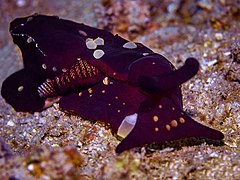| Heterobranchia Temporal range:
| |
|---|---|

| |
| Four examples of Heterobranchia | |
| Scientific classification | |
| Domain: | Eukaryota |
| Kingdom: | Animalia |
| Phylum: | Mollusca |
| Class: | Gastropoda |
| Subclass: | Heterobranchia J.E. Gray, 1840 |
| Taxonomic subcategories | |
|
informal group Lower Heterobranchia | |
Heterobranchia, the heterobranchs (meaning "different-gilled snails"), is a taxonomic clade of snails and slugs, which includes marine, aquatic and terrestrial gastropod mollusks.
Heterobranchia is one of the main clades of gastropods. Currently Heterobranchia comprises three informal groups: the lower heterobranchs, the opisthobranchs and the pulmonates.[2]

Diversity[edit]
The three subdivisions of this large clade are quite diverse:
- The Lower Heterobranchia includes shelled marine and freshwater species.
- Opisthobranchia are almost all marine species, some shelled and some not. The internal organs of the opisthobranchs have undergone detorsion (unwinding of the viscera that were twisted during torsion).
- The Pulmonata includes the majority of land snails and slugs, many freshwater snails, and a small number of marine species. The mantle cavity of the Pulmonata is modified into an air-breathing organ. They are also characterized by detorsion and a symmetrically-arranged nervous system. The pulmonates almost always lack an operculum and are hermaphroditic.
Taxonomy[edit]

Current taxonomy[3][4][5][6][edit]
- Heterobranchia
- Valvatoidea Gray, 1840
- Architectonicoidea Gray, 1850
- Mathildoidea Dall, 1889
- Omalogyroidea G. O. Sars, 1878
- Allomorpha
- Murchisonelloidea Casey, 1904
- Rhodopoidea Ihering, 1876
- Orbitestelloidea Iredale, 1917
- Cimoidea Warén, 1993
- Euthyneura
- Actenonacea
- Acteonoidea d'Orbigny, 1843
- Rissoelloidea Gray, 1850
- Tjaernoeiidae Warén, 1991
- Ringipleura
- Ringiculoidea Philippi, 1853
- Nudipleura
- Tectipleura
- Actenonacea
Older taxonomy[edit]
The families currently included in Heterobranchia have historically been placed in many different parts of the taxonomic class of gastropods. Earlier authors (such as J.E. Gray, 1840) considered Heterobranchia to consist of only marine gastropods, and conceptualized it as a borderline category, intermediate between the Opisthobranchia & Pulmonata, and all the other gastropods.[7]
The (sometimes recognized) category Heterostropha within the Heterobranchia, which includes such families as Architectonicidae, the sundial or staircase snails, is primarily characterized by a shell which has a heterostrophic protoconch, in other words the apical whorls are coiled in the opposite plane to the adult whorls. The classification of this group was revised by Ponder & Warén in 1988.[8]
According to the older taxonomy of the Gastropoda (Ponder & Lindberg, 1997) the Heterobranchia were ranked as a superorder.
2005 taxonomy[edit]

Heterobranchia is currently one of the main clades of gastropods. For a detailed taxonomy, see Taxonomy of the Gastropoda (Bouchet & Rocroi, 2005)#Clade Heterobranchia.
2010 taxonomy[edit]
Jörger et al. (2010)[9] have redefined major groups within the Heterobranchia: they created the new clades Euopisthobranchia and Panpulmonata.[9]
A cladogram showing phylogenic relations of Heterobranchia as proposed by Jörger et al. (2010):[9]
| Heterobranchia | ||
References[edit]
- ^ "PBDB". Paleobiology Database. Retrieved 2 April 2020.
- ^ Bouchet P. & Rocroi J.-P. (Ed.); Frýda J., Hausdorf B., Ponder W., Valdes A. & Warén A. 2005. Classification and nomenclator of gastropod families. Malacologia: International Journal of Malacology, 47(1-2). ConchBooks: Hackenheim, Germany. ISBN 3-925919-72-4. ISSN 0076-2997. 397 pp. http://www.vliz.be/Vmdcdata/imis2/ref.php?refid=78278
- ^ Bouchet, Philippe; Rocroi, Jean-Pierre; Hausdorf, Bernhard; Kaim, Andrzej; Kano, Yasunori; Nützel, Alexander; Parkhaev, Pavel; Schrödl, Michael; Strong, Ellen E. (2017). "Revised Classification, Nomenclator and Typification of Gastropod and Monoplacophoran Families". Malacologia. 61 (1–2): 1–526. doi:10.4002/040.061.0201. ISSN 0076-2997.
- ^ Pabst, Emily A; Kocot, Kevin M (2018-08-01). "Phylogenomics confirms monophyly of Nudipleura (Gastropoda: Heterobranchia)". Journal of Molluscan Studies. 84 (3): 259–265. doi:10.1093/mollus/eyy013. ISSN 0260-1230.
- ^ Moles, Juan; Giribet, Gonzalo (2021). "A polyvalent and universal tool for genomic studies in gastropod molluscs (Heterobranchia)". Molecular Phylogenetics and Evolution. 155: 106996. doi:10.1016/j.ympev.2020.106996. PMID 33148425. S2CID 226258146.
- ^ Wilson, Nerida G; Jörger, Katharina M; Brenzinger, Bastian; Schrödl, Michael (2017-11-01). "Phylogenetic placement of the enigmatic worm-like Rhodopemorpha slugs as basal Heterobranchia". Journal of Molluscan Studies. 83 (4): 399–408. doi:10.1093/mollus/eyx031. ISSN 0260-1230.
- ^ Haszprunar G. (1985). "The Heterobranchia ― a new concept of the phylogeny of the higher Gastropoda". Zeitschrift für zoologische Systematik und Evolutionsforschung. 23 (1): 15–37. ISSN 0044-3808.
- ^ Ponder, W. F.; Warén, A. (1988). "Classification of the Caenogastropoda and Heterostropha- A list of family-group names and higher taxa". Malacological Review Supplement. 4: 288–317.
- ^ a b c d e Jörger K. M.; Stöger I.; Kano Y.; Fukuda H.; Knebelsberger T.; Schrödl M. (2010). "On the origin of Acochlidia and other enigmatic euthyneuran gastropods, with implications for the systematics of Heterobranchia". BMC Evolutionary Biology. 10: 323. doi:10.1186/1471-2148-10-323. PMC 3087543. PMID 20973994.
Further reading[edit]
- Dinapoli A. (2009). Phylogeny and Evolution of the Heterobranchia (Mollusca, Gastropoda). Thesis, Frankfurt am Main, 176 pp. PDF[permanent dead link].
- Dinapoli A.; Klussmann-Kolb A. (2010). "The long way to diversity – Phylogeny and evolution of the Heterobranchia (Mollusca: Gastropoda)"". Molecular Phylogenetics and Evolution. 55 (1): 60–76. doi:10.1016/j.ympev.2009.09.019. PMID 19778622.